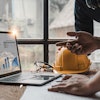
Significant changes on the horizon indicate an uncertain future for the engineering and construction (E&C) industry and its more than 100 million employees worldwide. Advancing digital technologies that include building information modeling, prefabrication, wireless sensors, automated and robotic equipment, and 3D printing will transform the entire industry. The substantial impact of full-scale digitization could help the industry escape its decades-long lack of productivity progress and generate an estimated $1.0 trillion to $1.7 trillion in annual cost savings.
 In an era where people are immersed in virtual reality in all aspects of life, intelligent systems and robots run the
In an era where people are immersed in virtual reality in all aspects of life, intelligent systems and robots run the
construction industry.World Economic Forum/The Boston Consulting Group (BCG)
“The myriad potential changes in the E&C industry leads to high ambiguity and makes it impossible to predict the future,” noted Santiago Castagnino, a BCG partner and coauthor of the report. “However, with scenario planning, involved stakeholders can prepare for a variety of possible futures.”
Over the past year, the World Economic Forum and BCG worked with more than 30 leading companies and other stakeholders from the E&C industry, conducting workshops in Berlin and London. The result of those workshops was the development of three future scenarios for the E&C industry. Although all three scenarios, outlined in the report, are extreme, they are plausible. In the “building in a virtual world” scenario, which many experts consider highly likely, design and engineering software systems are powered by artificial intelligence, and autonomous construction equipment replace most manual work throughout the E&C value chain.
 A corporate-dominated society uses prefabrication and modularization to create cost-efficient structures.World Economic Forum/The Boston Consulting Group (BCG)
A corporate-dominated society uses prefabrication and modularization to create cost-efficient structures.World Economic Forum/The Boston Consulting Group (BCG)
Although the report indicates that it remains unclear which scenario will unfold, there is little doubt that the real future will include elements of all three. According to Michael Burke, chairman and CEO at AECOM and cochair of the World Economic Forum Future of Construction initiative, “current business models, strategies, and capabilities will not be sufficient in any of these future worlds. This underscores that players along the construction value chain need to prepare strategically to thrive in the face of anticipated disruption.” In addition to recommending specific responses to each of the scenarios, the report provides a set of actions that will be relevant in any possible future.
The report states that 74% of the E&C company CEOs who attended this year’s annual meeting of the World Economic Forum in Davos reported that they considered attracting new talent and improving the skills of the existing workforce to be among the top three actions for keeping pace with upcoming disruptions. The other two priorities they named were improving integration and collaboration along the value chain (65%) and adopting advanced technologies at scale (61%). For each scenario, the report describes the most important changes that E&C companies must anticipate; explains how customer requirements, segment demand, regulations, processes, and technologies would change; and provides details on how the competitive position of existing industry players would be affected, what new entrants could be expected, and which new business opportunities will arise.
 A world with increasing conflicts over scarce resources and climate change rebuilds using environmental-friendly construction methods and sustainable materials.World Economic Forum/The Boston Consulting Group (BCG)
A world with increasing conflicts over scarce resources and climate change rebuilds using environmental-friendly construction methods and sustainable materials.World Economic Forum/The Boston Consulting Group (BCG)
A copy of the report can be downloaded here.
The new report follows two earlier reports from the World Economic Forum Future of Construction initiative published during the last year. Find earlier reports at: Shaping the Future of Construction: An Action Plan to Accelerate Building Information Modeling (BIM) Adoption, and Shaping the Future of Construction: An Action Plan to solve the Industry’s Talent Gap.



















